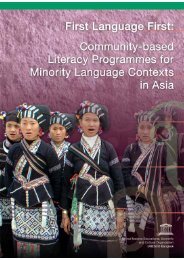Part II.pdf - MTB-MLE Network
Part II.pdf - MTB-MLE Network
Part II.pdf - MTB-MLE Network
Create successful ePaper yourself
Turn your PDF publications into a flip-book with our unique Google optimized e-Paper software.
APPENDIX 1<br />
Essential Concepts Used in the Article<br />
The distinction of language and dialect is seen from the linguistic point of view emphasizing<br />
intelligibility. Thus, only if people speaking different speech varieties sufficiently understand each<br />
other and can communicate without difficulties, they speak dialects of a same language. If the<br />
intelligibility between speakers of different speech varieties is insufficient, they speak different<br />
languages.<br />
Mother tongue may refer to different situations depending on the definition criteria used (Baker &<br />
Prys Jones 1998; Skutnabb-Kangas 1988, 16-18; 2000, 105-108; UNESCO 2003b, 15). Other terms<br />
such as or first language (L1), vernacular (language), native language or home language are also<br />
used to refer to the mother tongue. Bilingual or multilingual people may have several mother tongues.<br />
The mother tongue may refer to at least the following situations: The mother tongue is a language:<br />
(a) that one has learnt first; (b) one identifies with or is identified as a native speaker of by others;<br />
(c) one knows best; and (d) one uses most.<br />
Second language (L2) is a language that is not the mother tongue of a person, but she/he speaks<br />
or has to study it. It may be a foreign language or another non-native language of the learner.<br />
Second language may also be a language that is not spoken in the immediate environment of the<br />
learner, or it may be a language widely spoken outside the home. For ethnolinguistic minorities,<br />
the second language usually is the national or the official language that is used in contexts such as<br />
schools and interaction with government agencies or in communication with other language groups.<br />
Local language is a language (a) without a written form; (b) for which language development is<br />
not yet complete; or (c) that is otherwise not considered suitable for education, for example, due to<br />
its low status or small number of speakers (CAL 2001; Robinson 1999; Vawda & Patrinos 1999;<br />
Walter 2004). In minority settings, the local language is usually the first language of the given<br />
ethnolinguistic minority group.<br />
Language of Wider Communication (LWC) is a language that speakers of different mother tongues<br />
use to communicate with each other. LWC is also called lingua franca or trade language. At the<br />
national level, LWC is usually the national or official language. In multilingual situations of<br />
South-East Asia, LWCs are usually major regional languages that various ethnolinguistic groups<br />
use in communication with each other.<br />
Language (or medium) of instruction is a language that is used for teaching and learning the subject<br />
matter of the curriculum in a given educational system or a part of it. Bilingual education refers<br />
to the use of more than one language in education. In an ideal situation education begins with the<br />
learner’s first language (L1) and a second language (L2) is gradually introduced later. Biliteracy<br />
refers to the use of two (or more) languages for reading and writing (Hornberger 2003). Benson<br />
(2003) provides a useful concept of mother tongue-based bilingual education referring to “a form<br />
of schooling that uses the L1 for teaching beginning literacy (reading and writing) and basic concepts<br />
such as mathematics, while teaching the L2 as a second or foreign language, ideally using appropriate<br />
133
















